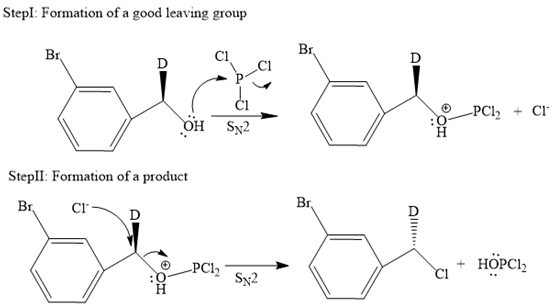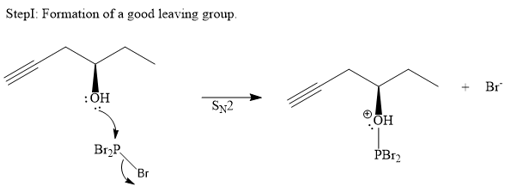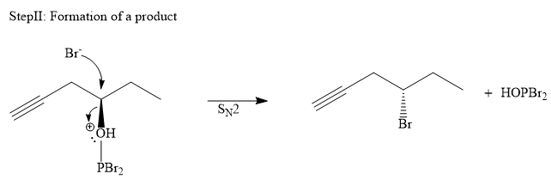
(a)
Interpretation:
The complete, detailed mechanism for the given reaction is to be drawn and the product of the reaction is predicted.
Concept introduction:
A way to convert an alcohol into an
In the first step of the reaction, the oxygen atom of an alcohol is electron-rich and acts as a nucleophile, whereas the phosphorus atom in
Answer to Problem 10.3P
The complete and detailed mechanism for the given reaction is:

The product formed in given reaction and the overall reaction is:

Explanation of Solution
The given reaction is:

Deuterium is an isotope of hydrogen. Its chemical behavior is identical to hydrogen but serves as a label in reactions.
As a first step, the oxygen atom of an alcohol is electron-rich and acts as a nucleophile, whereas the phosphorus atom in

Note that, the stereochemical configuration of the carbon atom does not change at the end of this step.
In the second step, the chloride ion generated in the previous step acts as a nucleophile and the phosphorus-containing species acts as the substrate. The chloride ion attacks the carbon atom to which

Note that, though bromine is a good leaving group, but, since it is attached to the
When an alcohol is treated with
(b)
Interpretation:
The complete, detailed mechanism for the given reaction is to be drawn and the product of the reaction is predicted.
Concept introduction:
A way to convert an alcohol into an alkyl halide is to use phosphorus tribromide,
In the first step of the reaction, the oxygen atom of an alcohol is electron-rich and acts as a nucleophile, whereas the phosphorus atom in
Answer to Problem 10.3P
The complete and detailed mechanism for the given reaction is:

The product formed in given reaction and the overall reaction is:

Explanation of Solution
The given reaction is:

In the substrate above,
As a first step, the oxygen atom of an alcohol is electron-rich and acts as a nucleophile, whereas the phosphorus atom in

Note that, the stereochemical configuration of the carbon atom does not change at the end of this step as the carbon atom is not involved in this step.
In the second step, the bromide ion generated in the previous step acts as a nucleophile and the phosphorus containing species acts as the substrate. The bromide ion attacks the carbon atom to which

When an alcohol is treated with
Want to see more full solutions like this?
Chapter 10 Solutions
ORG.CHEM W/TEXT+SOLU.MANUAL
- Please predict the product of the following reaction, and draw the complete, detailed mechanism.arrow_forwardDraw a complete, detailed mechanism for this reaction.arrow_forwardDraw the complete, detailed mechanism for the reaction shown here. Will the product be optically active? Explain.arrow_forward
- Draw the complete mechanism and the major organic product for each of the following reactions.arrow_forward(SYN) Show how to synthesize the following molecule from any compounds containing two carbons. Draw the complete, detailed mechanism for the reaction.arrow_forwardPlease draw the complete, detailed mechanism for each of thesearrow_forward
- Predict the major products of the following reactions. Draw the complete, detailed mechanism that leads to the formation of each of those products.arrow_forwardPlease draw the complete, detailed mechanism of the reaction step by step.arrow_forwardPredict the major product of each of the reactions shown here and provide the complete, detailed mechanism.arrow_forward
- Predict the major product of each of the following reactions and provide the complete, detailed mechanismarrow_forwardDraw a complete, detailed mechanism AND predict the major organic product for the following transformations a, b & c.arrow_forwarddraw all of the mechanism for this given acidarrow_forward
 ChemistryChemistryISBN:9781305957404Author:Steven S. Zumdahl, Susan A. Zumdahl, Donald J. DeCostePublisher:Cengage Learning
ChemistryChemistryISBN:9781305957404Author:Steven S. Zumdahl, Susan A. Zumdahl, Donald J. DeCostePublisher:Cengage Learning ChemistryChemistryISBN:9781259911156Author:Raymond Chang Dr., Jason Overby ProfessorPublisher:McGraw-Hill Education
ChemistryChemistryISBN:9781259911156Author:Raymond Chang Dr., Jason Overby ProfessorPublisher:McGraw-Hill Education Principles of Instrumental AnalysisChemistryISBN:9781305577213Author:Douglas A. Skoog, F. James Holler, Stanley R. CrouchPublisher:Cengage Learning
Principles of Instrumental AnalysisChemistryISBN:9781305577213Author:Douglas A. Skoog, F. James Holler, Stanley R. CrouchPublisher:Cengage Learning Organic ChemistryChemistryISBN:9780078021558Author:Janice Gorzynski Smith Dr.Publisher:McGraw-Hill Education
Organic ChemistryChemistryISBN:9780078021558Author:Janice Gorzynski Smith Dr.Publisher:McGraw-Hill Education Chemistry: Principles and ReactionsChemistryISBN:9781305079373Author:William L. Masterton, Cecile N. HurleyPublisher:Cengage Learning
Chemistry: Principles and ReactionsChemistryISBN:9781305079373Author:William L. Masterton, Cecile N. HurleyPublisher:Cengage Learning Elementary Principles of Chemical Processes, Bind...ChemistryISBN:9781118431221Author:Richard M. Felder, Ronald W. Rousseau, Lisa G. BullardPublisher:WILEY
Elementary Principles of Chemical Processes, Bind...ChemistryISBN:9781118431221Author:Richard M. Felder, Ronald W. Rousseau, Lisa G. BullardPublisher:WILEY





